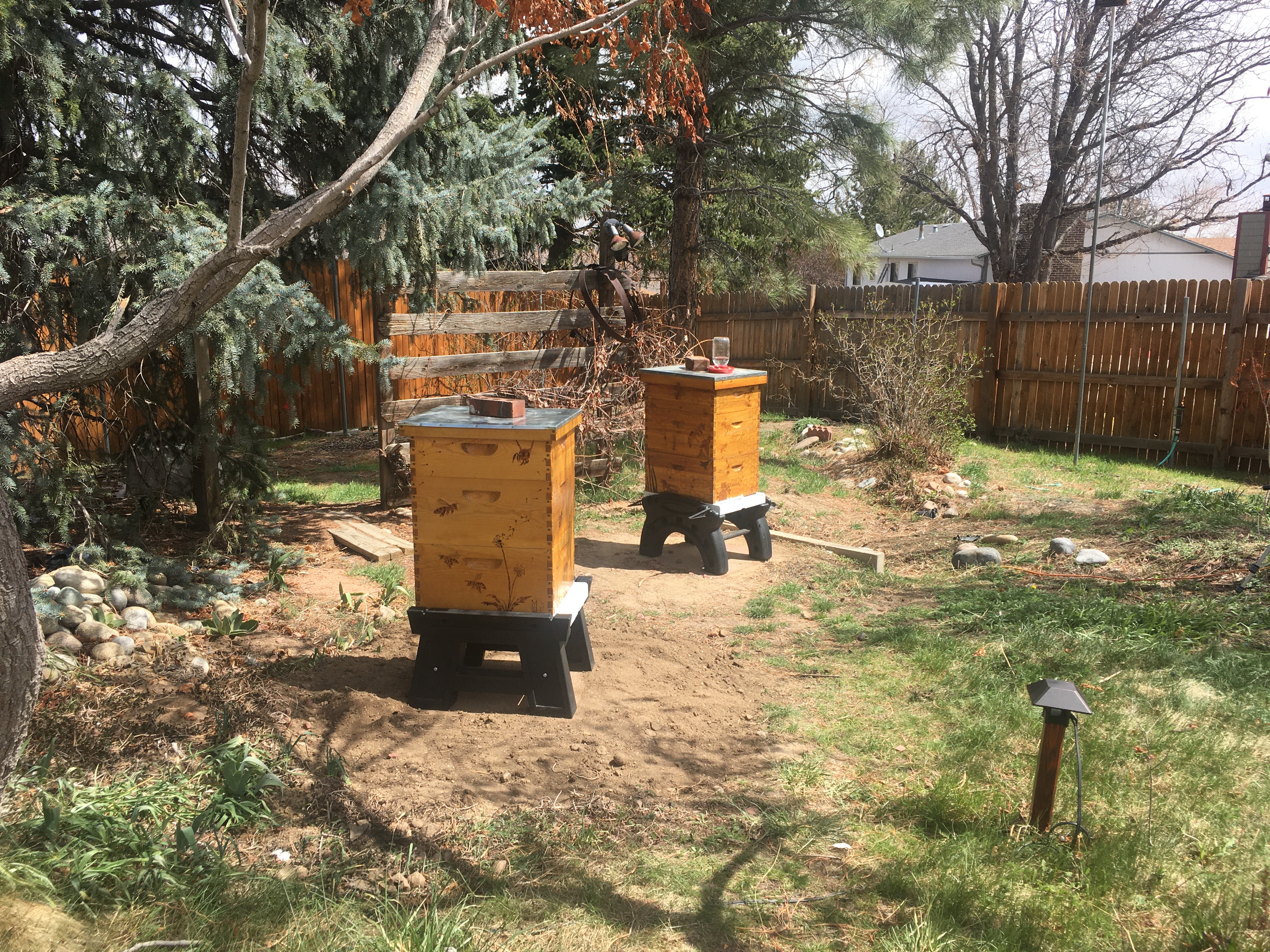
Disclosure: This post contains affiliate links – this means that at no additional cost to you, I may earn a small commission if you make a purchase through them. As always, my opinions are my own and I write based on my experiences. Beekeeping is very location dependent, so what works for me may not necessarily work for you.

As winter draws to a close, it’s time to start thinking about where the bee nucs, packages, and/or splits that are coming this spring (or swarms that you’ll be lucky enough to catch!) should be placed. There are several key things to consider when deciding where you want to set your apiary up – whether you’re looking at your own backyard or are being hosted in the middle of a farmer’s field. And while it’s not impossible to move colonies after they are established, it’s a lot easier to put them in their permanent location from the start.
I created a hive location evaluation checklist that you can use to help determine if a location you’ve chosen is a good place for a beehive. The points on it are each discussed in detail throughout this post.
What to Consider When Deciding Where to Put a Beehive
1. Local Laws and Regulations
First and foremost, look into the beekeeping laws for where you are placing the hives. Where I live (Aurora, CO), our ordinance requires that hives be placed a minimum of five feet away from the closest fences with the back of the hive facing the nearest neighboring property, that there be a barrier at least 6 feet tall, 10 feet out from the hive to force the bees up as they leave the property (luckily my fences are 6 feet!), that a water source has been provided nearby to keep them from collecting at neighbor’s pools and birdbaths, and that you limit how many colonies you have based on your property size. Our ordinance also specifies requirements for maintaining hives like re-queening aggressive colonies and cleaning up hive debris to discourage robbing. You’ll definitely want to look into the laws for your location to help you decide how to legally place your hives.
What if the laws at your location prohibit beekeeping?
Beekeeping is so much fun – don’t give up yet! There are a few things you can do.
- Try to find nearby locations that will host your beehive for you – i.e. let you keep it on their property, maybe in exchange for honey rent or simply because they like having bees around for pollination. You would still be in charge of all inspections and maintenance.
- You can find these locations by asking your local bee club for recommendations, reaching out to community gardens, parks, and cemeteries (the bee club I am a member of keeps hives at a local cemetery!), or even posting an ad on craigslist to see if you can find someone who will let you put a hive on their property.
- Start reaching out to your neighborhood leaders to see what you need to do to try to get the law changed. A lot of places are still coming around to allowing beekeeping, so it may just be that your neighborhood hasn’t had someone pushing for it yet. If you do approach them, be educated in advance about the benefits of beekeeping in the community and ways that any nuisances to neighbors can be managed and minimized. I’ve even heard of people getting approved by HOA’s to place hives in their townhouse backyards by presenting compelling information on the benefits!
2. Direction
Set up your hive with the entrance facing southeast, if possible. If this doesn’t work in your yard, don’t worry, you can still set up your hives facing another direction. However, studies have shown that when choosing their own home sites, wild bees do show a preference for hives with southern facing entrances1, so it may support their natural tendencies. Beyond that, it’s also really convenient because the sun will warm up the front of the hive early in the day. This means the bees will get up and going a little earlier, and any snow blocking the entrance will melt off quickly. We’ve had a couple crazy snows this year, but I’ve never had to go out to clear the entrance because the sun always does it for me before I’m even awake!
3. Sun
An ideal location is one that has lots of morning sun, and some afternoon shade/dappled sun. It kind of depends on your location though – if you have cold winters and hot summers like we do, this balance helps get the hive warmed up and going in the morning but helps the bees not overheat in the hot summer afternoons. If you are in a location that’s really hot year round, you may want a little more shade to help them keep cool. And if you’re in a location that has a problem with small hive beetles (luckily, we don’t in Colorado), you may want to opt for more direct sun because the beetles tend to prefer the shade. Bees have incredible methods to keep their hive at their desired temperature, so if you can’t manage what seems like the ideal ratio of sun/shade for your location, that’s ok.
4. Wind
If you live in a very windy location, it’s a good idea to put a hive somewhere that has a bit of wind protection. You can use a hedge or tree or build a barrier as a sort of wind break. On the flip side though, don’t go too crazy. Good ventilation is very important for hive health so don’t place a hive somewhere where it’s closed in and musty, or damp.
5. Level, Dry, Firm Ground
To keep a hive workable, especially if you aren’t using foundation in your frames, make sure the hive is completely level, at least from from side to side. Front to back, the hive should be level or slightly tilted towards the entrance to help any water that gets inside drain out. Place the hive on dry, firm ground with good drainage so that it doesn’t sink in over time (choosing dry, firm clay or rocky ground over moist or sandy soil can also help with small hive beetles). Of course, if a location isn’t level, it’s not very hard to make it level. I recently set up a new hive location and took this timelapse of my setup which mostly involved a lot of what’s called “screeding” to level the area with topsoil and sand – if you don’t know how, look up some videos on it and you’ll see it’s really easy:
6. Spacing
In nature, bee colonies don’t live very close together1. In your backyard, they’ll likely be forced to be a lot closer than is natural, but that’s ok. Try to space them at least a few feet apart to minimize drifting (bees who come home and go into the wrong hive – this can increase the spread of diseases), and make it easy for yourself to access all sides of the hive. I like to have at least a couple of feet all around the hive to give myself space to work it from all sides. Clearing the area around the hive of tall weeds or grasses can also help minimize access for pests like ants. If you don’t have any choice but to put hives right next to each other, you can experiment with facing them different directions to reduce drifting as well.
7. Proximity to House / Foot Traffic
It is best if the hive can be placed out of the way of lots of foot traffic from your family, pets, and other people (like a public sidewalk). This minimizes the chances of a kid getting stung because they stepped on a bee in the grass, or a pet getting stung because they got a little too curious. You may want to place it somewhere you can see it from a window, just for the fun factor.
8. Water Source
Just like humans, bees need water to live. If you have access to a stream or pond, placing a hive nearby to that could be a great choice. If you don’t, you will just need to provide them a water source and make sure to keep it filled regularly, and provide floats or rocks to keep the bees from drowning. Dont assume the bees will just find their own source – they very well might, but that source could be your neighbor’s pool and your neighbors might not appreciate that. I like to use a poultry waterer (I like these bases that fit on quart mason jars) with some pebbles to prevent drowning.

9. Elevated
A hive should not be placed directly on the ground. You can buy dedicated hive stands that come with frame holders off the side – I have both the old and new versions of this stand, and like them. They’re a little expensive, especially if you’ll have several hives, but very easy and convenient. You can also just build your own stand from wood or cement blocks. However you do it, keeping the hive off the ground is a must to keep it dry and safe from the elements, as well as safe from predators and pests such as skunks, raccoons, and ants.
10. Speaking of Predators…
Think about what types of predators live in your area. Do you have skunks and raccoons? Set your hive up off the ground and make sure to put a weight (like a big rock or brick) on the lid. But if you have bears? You’ll need to set up an electric fence around your hives! Bears love bees – both for the honey and the nutritious, protein filled brood (I guess Winnie the Pooh is a vegetarian and just goes for the honey). Check out this video of what a bear can do to a hive – it’s devastating. Seriously, don’t play with fate if you have bears in your area – get the electric fence!
What if you can’t meet most of these requirements? Don’t let that stop you from keeping bees – try anyway and just do the best that you can! These are things you should think about, but you’ll very likely be successful even if you can’t meet all of these items. Bees adapt amazingly well and have been found living in some crazy places!
Did I miss any critical things to think about when deciding where to put a beehive? Do you have any questions? Let me know in the comments below.
References
(1) Seeley, Thomas D. The Lives of Bees: The Untold Story of the Honey Bee in the Wild. Princeton, Princeton University Press, 2019.



Great info and very thorough! Nice work!
🙂
Thank you!